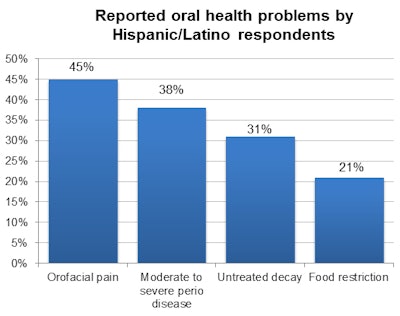
A recent study took an in-depth look at how cultural background and ethnic identity affect the oral health of U.S. Hispanics and Latinos. More than half of U.S. Latinos have experienced poor oral health-related quality of life, the study found.
The researchers hope their findings might help dental professionals better address issues concerning this diverse population.
Marushka Silveira, BDS, MPH, PhD, from the National Institute on Drug Abuse led the study, which was published in Ethnicity & Health (January 18, 2018).
"As healthcare providers, dentists should consider a variety of issues, including the personal beliefs and values of their patients, in developing treatment options for their patients," Dr. Silveira and co-author Bruce Dye, DDS, MPH, told DrBicuspid.com by email. "Having a greater understanding of issues that drive quality of life concerns will help to facilitate decision-making that results in better patient outcomes."
Breaking down quality of life
The U.S. Hispanic/Latino population is a diverse group of people that vary by background and also immigration generation and language spoken at home. Yet few, robust studies have accounted for these differences when looking at the oral health of Latinos.
“As healthcare providers, dentists should consider a variety of issues ... in developing treatment options for their patients.”
Therefore, the researchers used data from the 2008-2011 Hispanic Community Health Study/Study of Latinos, which is one of the most comprehensive studies of the population, according to Drs. Silveira and Dye. The study gauges oral health-related (OH-related) quality of life through questionnaires and a dental exam.
"The Hispanic Community Health Study/Study of Latinos ... includes an array of interviews and examinations to determine risk factors and several health outcomes in the Hispanic/Latino population with sufficient sample sizes to examine variation by Hispanic/Latino background," Drs. Silveira and Dye wrote.
The Ethnicity & Health study included about 13,000 survey respondents. The included respondents were all dentate adults of varying backgrounds, including Cubans, Dominicans, Mexicans, and Puerto Ricans.
More than half of respondents experienced poor oral health-related quality of life in one form or another. About half reported orofacial pain within the past year, and another 38% had moderate to severe periodontal disease.

The researchers also found that cultural factors, such as acculturation, a measure of how much a person has adopted the customs and cultures of the prevailing (or host) society, and ethnic identity, a measure of pride and belonging to a specific ethnic group, were associated with some but not all aspects of oral health-related quality of life. For instance, having a low sense of pride in one's heritage was associated with increased food restriction but no other oral health metrics, a finding that surprised Drs. Silveira and Dye.
"Some of the associations between cultural factors and OH-related quality of life were no longer significant after adjusting for Hispanic/Latino background," they wrote. "While these associations did not consistently vary by Hispanic/Latino background, they varied by several socio-behavioral characteristics, suggesting that one or more aspects of an individual's Hispanic/Latino background influenced these associations."
Applying the findings to practice
While the study excelled at accounting for multiple facets of the U.S. Latino experience, it did not account for bicultural or edentulous individuals. The study also included respondents from stable communities and may not be representative of migrant workers.
Nevertheless, this study is important and ripe for follow-up research. Future studies could investigate the underlying association between cultural factors and oral health-related quality of life, and dentists can build upon their findings in practice, Drs. Silveira and Dye suggested.
"One way that the dental community can build upon our findings is to incorporate culturally competent health education and patient-centered treatment approaches with the goal of improving OH-related quality of life among Hispanic/Latinos," they noted. "Our findings also inform the development of community-based oral health promotion programs that aim to improve OH-related quality of life in this diverse population."



















